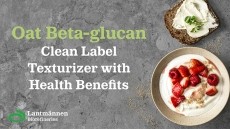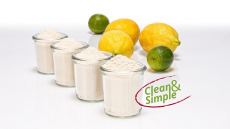New carrageenan technology eliminates gelatin, cuts costs
in gel sets, which claims to cut costs in half and eliminate the
need for gelatin or locust bean gum.
The company believes its new ingredient, a pure carrageenan achieved through special processing conditions, will revolutionize the manufacture of products including jelly-type water deserts, beverages and bakery icings and fillings.
Carrageenan, a gum extracted from seaweed and used for texture and viscosity in food products, generally needs to be utilized in combination with gelatin, refined locust bean gum or other texturizing ingredients in order to achieve a clear gel set. However, rising prices for locust bean gum as well as the often undesirable addition of protein into the ingredient formulation have resulted in a non-protein source of the product being on the "wish-list" of manufacturers for a long time, said PL Thomas (PLT).
The company's new Ceambloom 3240, which was launched at the IFT trade show last month, claims to allow for a direct substitution of gelatin, while achieving the desired mouthfeel, texture and clarity.
And because it is an all vegetable ingredient, it can also be used in Kosher products, said the firm.
Ceambloom also claims to eliminate syneresis - the process by which a liquid is separated from a gel owing to further coagulation - a problem often observed in yogurt products that develop a layer of liquid.
But because protein is not used, syneresis does not occur easily, which also allows for an extended shelf life. And no protein also means a reduction in factors that cause off flavors and odors, again extending shelf life, said PLT, although the firm has not yet put a time frame on shelf life extension.
In partnership with Spain's Ceamsa, PLT says it has been working on the development of this product for years.
"This is something we've been waiting for and hoping for, and now we have it, and that's opened up a whole new arena," said PLT's business development manager Rodger Jonas.
"Previously it was too expensive to get this type of product. We had solutions but these weren't cost-effective for use in mainstay products. So it remained on people's wish-list but from a technical standpoint it was just not achievable. Now, it can be done efficiently and economically," he told FoodNavigator-USA.com.
The company claims to have achieved this through a combination of selecting the right type of carageenan and using a particular processing method.
According to Jonas, the new method does not involve any "dramatic switch" of the raw material.
"It's still all natural, it still falls under the same regulations as regular carrageenan. We just got smarter about how to do it," he said.
The popularity of carrageenan has grown in industrialized countries by at least 5 to 7 per cent per year, particularly on the back of growing demand for convenience foods. However the cost of the ingredient has also recently shot up. Carrageenan is extracted from seaweed, largely sourced from the Philippines and Indonesia, and a strong pull in global carrageenan stocks, impacted by an increase in demand from China's booming processed food industry, has led to price spikes.
But according to PLT, Ceambloom offers significant cost advantages to manufacturers, slashing these by up to 50 percent compared to a standard carrageenan/locust bean gum formulation.
And because of its clean flavor profile it also claims to allow for an enhanced flavor release, as there is nothing to "dull" the flavor received, said the firm.
The product is also marketed as having an increased heat stability, being quick setting and easy to work with.
Manufactured by PLT's partner Ceamsa, Ceambloom also recently became available in the European market. In the US, the product attracted "tremendous" interest at the IFT, and is already being tested by firms in jelly, bakery, dairy and beverage products, said PLT.
According to Jonas, the first finished goods made with Ceambloonm should appear on the market within the next six months.
Jonas claims the new product will "immediately replace" standard carageenan and locust bean gum combnations.



























